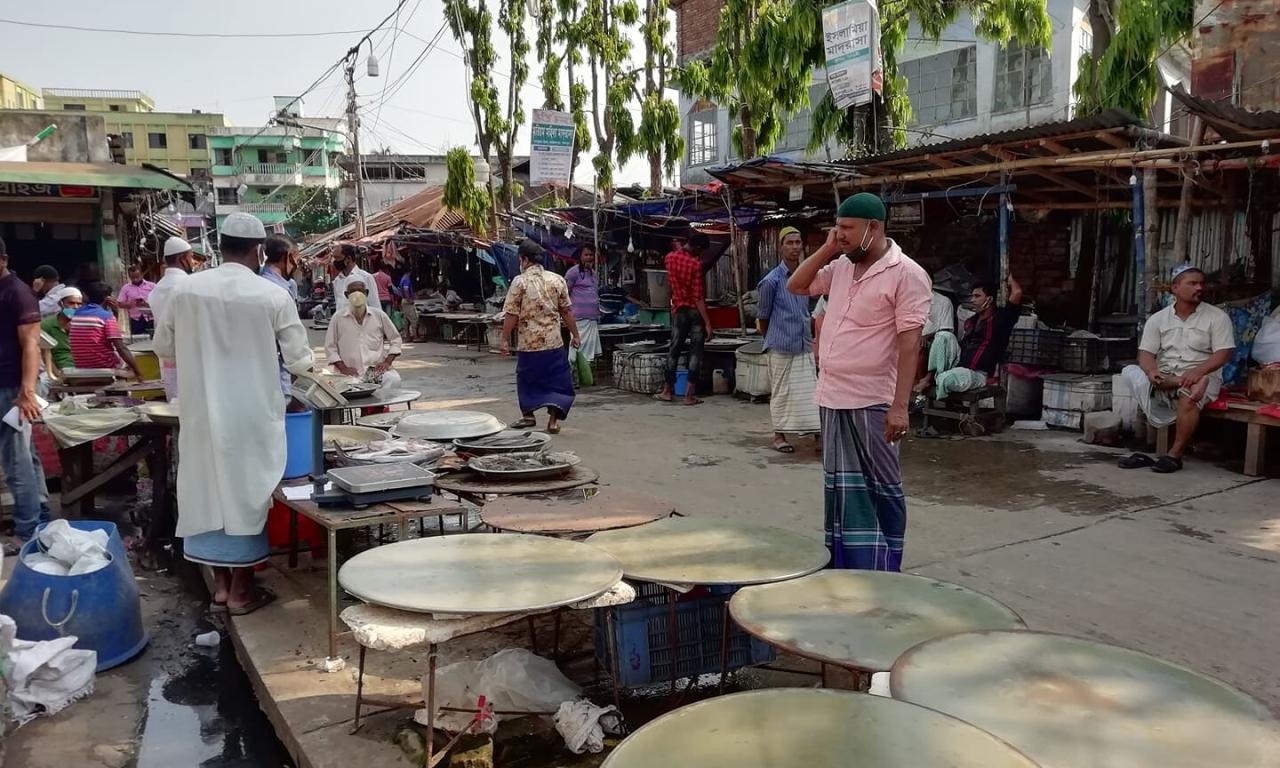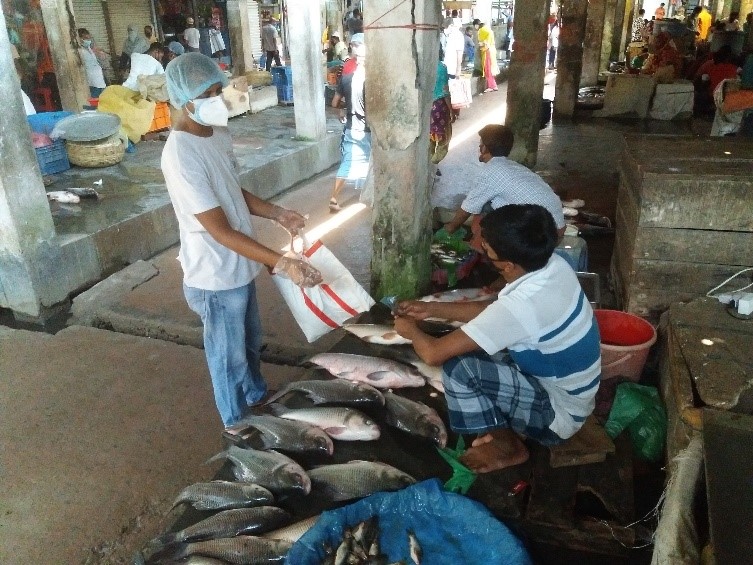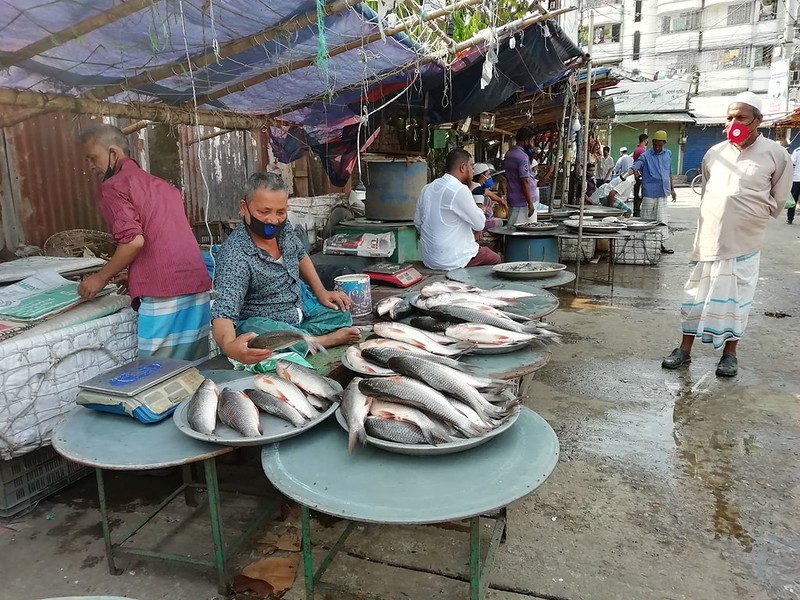
In this series of blogs, experts from WorldFish’s focal countries share their personal insights on the impacts of COVID-19 on fishing, aquaculture, and everyday life.
In part 2 of this blog, our expert panel Dr. Mohammad Mahfujul Haque, Dr. Abdullah-Al Mamun, and Mr. Mamun-Ur-Rashid discuss COVID-19 impacts on the fish supply chain in Bangladesh, and options for aiding their recovery.
Markets: COVID-19 has transformed wet markets in Bangladesh. Many fish vendors are choosing to stay home due to health concerns or lack of fish to sell. For those still operating, business may be less profitable than usual. Fish prices fell during the first weeks of April, in line with reduced demand, despite fish being the most consumed animal-source food in Bangladesh. Dr. Haque noted that in one of Mymensingh’s many retail markets, which usually supported fifteen fish vendors, only six or seven were present at the height of the crisis.
In Bangladesh’s capital city, Dhaka, factory workers are some of the primary consumers of pangasius and tilapia, which are produced inexpensively on the city outskirts by a network of fish farmers. At the start of the crisis, millions of workers migrated back to their hometowns, which resulted in plummeting demand. Demand for fish has also dropped outside of Dhaka. Dr. Haque noted that in one of Mymensingh’s many markets—that usually supports fifteen fish vendors—only six or seven were present at the height of the crisis. At the lowest point, the price of a kilogram of pangasius in Mymensingh retail markets was said to have plummeted from BDT 120/kg to BDT 50/kg.
Savvy consumers used to carefully selecting recently harvested fish from an abundance of locally available species, had fewer species to choose from, and these were often less fresh than usual. While most fish retail prices have slowly returned to normal, Dr. Mamun noted that tilapia and pangasius prices remain lower than usual. According to Dr. Haque pangasius farmgate prices have been particularly affected as the number of intermediaries in the value-chain has reduced. Mr. Mamun-Ur-Rashid mentioned that in Dhaka retail markets, pangasius now sells from around BDT 67/kg to BDT 93/kg.

Fishers: Very little fishing is thought to have taken place during the early phases of the pandemic, even though there were no regulations preventing it. Fishers stayed home out of concern for their health and were hesitant to fish when demand for fish is plummeting. Higher transport costs and unreliable transport acted as a further disincentive to fish. Many fishers lost income at the beginning of the crisis when they were unable to arrange transport for their most recent catch. Fishers often have outstanding debts to wholesalers and boat owners that cannot currently be repaid.
Bangladesh has now entered the annual fishing ban period for its most important fish, the hilsa shad. Small-scale fishers are temporarily prevented from fishing the Lower Meghna River and shallower part of the Bay of Bengal, compounding their difficulties. Although the pandemic has upended fishers’ livelihoods, many are hopeful that the reduction in fishing rates this season will lead to a bountiful breeding season and healthier fish stocks next year. Dr. Haque speculated that farmed fish prices could decrease in the future if wild fish became more available.
Farmers: The COVID-19 crisis struck in April, just before peak harvest season. As farmers watched prices and demand plummet and transportation systems break down, many decided to retain fish in their ponds instead of harvest. These farmers now face a high degree of uncertainty over when prices will stabilize. One interviewee predicted prices may remain low even after measures are relaxed when other farmers also begin harvesting fish and that surplus supply will depress prices further.
Traders often pay farmers for their fish after they have been sold. Farmers now fear that they will lose the income from their crop if traders are unable to sell fish on their behalf, and unsold fish cannot be returned due to transport disruptions. They also fear these disruptions could prevent traders from picking up the fish in the first place. Although retaining fish in ponds appears to be a safer immediate option for some, it also creates the prospect of running out of money for fish feed within one to two months, leaving no choice but to harvest. Delayed harvesting has also meant that ponds are not restocked in at the onset of the monsoon (the start of the main growing season), potentially leading to dramatically reduced supply of fish in the first half of 2021. Some farmers have attempted to reduce costs by letting go of workers, contributing to falling employment.
Seed: Hatchery owners were also gearing up for a new production cycle at the onset of the COVID-19 crisis. Farmers’ uncertainty and inability to empty their ponds has caused demand for fish seed to fall dramatically. Some hatcheries do not have separate nursing ponds and are unable to store seed for more than five to seven days. Hatchlings must be sold on a continuous basis or must be thrown out as they outgrow the space available. In Northwest Bangladesh hatcheries were reported to have reduced production by at least 30-40%, and four out of twenty-one have shut down completely. Nurseries in Northwest Bangladesh have seen similar sales decreases of 30-40%. Systems for supplying fry on credit to farmers are no longer possible as nurseries themselves face a liquidity crisis due to lack of sales.
Hatcheries and nurseries also face rising production costs, as many inputs such as pituitary glands, hormones, probiotics, and prebiotics are imported from outside Bangladesh. As these inputs have become more challenging to access, prices have risen. Pituitary gland hormone has tripled in price since the crisis started. Transport has been an additional logistical challenge. Many farms are accustomed to getting their fish seed through a network of connections from around the country. Smallholders typically use public transport to move fry to their farms, but this is not currently fully operational.

Feed: Feed mills are highly dependent on inputs from abroad to produce feed. Around 70-80% of ingredients used to make fish feeds in Bangladesh are imported. Imported inputs have become more challenging to procure and prices have increased. This has led to speculation about whether millers will compromise on quality, with some experts predicting a 40% reduction in feed supply will occur due to input shortages and less demand from farmers. Commercial smallholder producers are worried about how they will access feeds. It is time consuming and expensive for farmers to source feed ingredients individually from local sources, given limited market hours and reduced transportation options.
Options for recovery: Demand for fish products will likely be slow to return to pre-crisis levels, causing difficulties for actors throughout the fish value chain. During this period, government could include fish in its public procurement programs. This would have the double benefit of supporting fisher and fish farmer livelihoods while also preventing widespread malnutrition that could depress economic growth for years to come. The example from Noakhali district reported in part 1 of this blog is a successful example of this approach in action.
Despite government initiatives to facilitate transportation of food supplies, all segments of the fish value chain continue to face challenges with logistics that impede flows of fish and critical production inputs. Available transport options come with additional expenses that are too costly for many actors to absorb, especially when fish prices were at a historic low. Government could coordinate more closely with industry representatives to address these challenges and facilitate the free flow of food and agricultural inputs across the country. As these issues are not unique to the fish value chain, addressing them would likely help all food supply chains in Bangladesh.
Micro, small, and medium enterprises (MSMEs) – most of them informal – account for the bulk of Bangladesh’s food economy and are vital to a functioning food system. Fishers, farmers, and other actors in the fish value chain confront a mixture of rising costs, accruing debts, and reduced incomes that, when combined, can be disastrous for microenterprises. Cash transfers or loan options that are friendly to microenterprises may be essential to keep such businesses solvent.
As many of Bangladesh’s traders, marketeers, and street vendors operate in the informal sector, the government can support social protections, such as a safe working environment (e.g. physical distancing in marketplaces) and access to affordable health care. MSMEs need help to operate safely during the COVID-19 crisis. Providing businesses with sanitation protocols to follow and supporting them in developing new ways of doing business, such as digitalizing ordering and delivery processes, will help them to keep their doors open and their workers safely employed.
